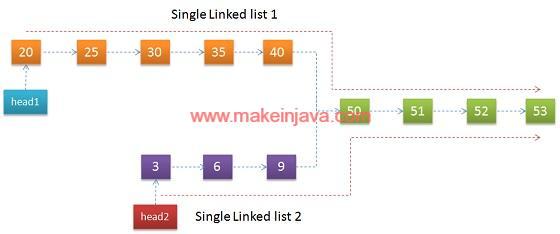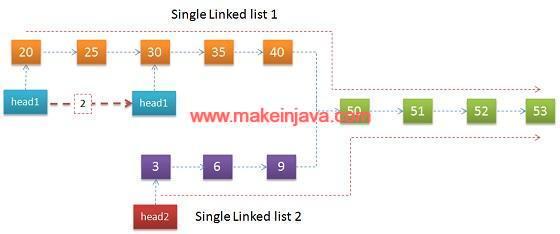- Given two single linked lists, find out the intersection point of two single linked lists.
- Traverse the single linked lists using non recursive or iterative algorithm.
- Suppose, we have two linked lists and they meets at certain point
- then, we would like to find out the meeting or join point.
- We have shown two single linked lists, Linked list 1 and linked list 2 in Fig 1.
- Both linked lists are intersected at node 50.
- As per our problem statement, we are interested in Node 50, where two linked lists intersects or joins together.

- Let us analyze the single linked lists shown in Fig 1
- Both single linked lists are joined together at node 50
- All the nodes after node 50 are common in both linked list (shown in green color).
- The nodes prior to node 50 differ in both the list i.e. length (or/and data) of lists varies prior to node 50.
- If we can able to find out the difference in length, prior to node 50, then we can figure out the join point of linked lists.
Algorithm – find intersection or join point of two single linked lists in java
- Find out the length of single linked list1 & list2
- length of single linked list1 as shown in Fig 1 is 9
- length of linked single linked list2 is 7
- Find out the differences of length of two linked lists
- difference = length of larger list – length of smaller list
- difference = 9 – 7 => 2
- So, we can reduce two nodes from larger linked list (i.e. Linked list 1)
- then Linked list 1 will become equal to Linked list 2
- Move the head pointer of larger list by 2
- We have shown head1 reference shift by 2 in Fig 2
- Now, both head1 (pointing at Node 30) and head2 will travel equal nodes
- i.e Both linked lists will travel 7 nodes
- Compare the address of both nodes during traversal
- Address will be same at Node 50
- So, Node 50 will be join point
- Got the join points of both linked lists
Time complexity of algorithm is O (n).

Program – find intersection or join point of two single linked lists in java
1.) IntersectionPoint Class:
- We are passing head of both single linked lists
- We are finding the join point by calling intersectionPoint method.
package org.learn.Question;
import org.learn.List.Node;
public class IntersectionPoint {
public static Node intersectionPoint(Node head1, Node head2) {
int length1 = length(head1);
int length2 = length(head2);
Node largerList = null;
Node smallerList = null;
if (length1 > length2) {
largerList = head1;
smallerList = head2;
} else {
largerList = head2;
smallerList = head1;
}
return getIntersetPoint(largerList, smallerList, Math.abs(length1 - length2));
}
private static Node getIntersetPoint(Node largerList,Node smallerList,int lengthDifference) {
int count = 0;
while (count++ < lengthDifference) {
largerList = largerList.next;
}
while (largerList != null && smallerList != null) {
if (largerList == smallerList)
return largerList;
largerList = largerList.next;
smallerList = smallerList.next;
}
return null;
}
public static int length(Node head) {
int length = 0;
while (head != null) {
head = head.next;
length++;
}
return length;
}
public static Node insert(Node head, int data) {
while (head.next != null)
head = head.next;
head.next = new Node(data);
return head.next;
}
public static void print(Node head) {
while (head != null) {
System.out.printf("%d ", head.data);
head = head.next;
}
System.out.println("");
}
}
2.) App Class:
- We are creating two single linked lists (head1 and head2) in main method.
- We will print single linked lists.
- Finding the join points of Y shaped linked lists
package org.learn.Client;
import org.learn.List.Node;
import org.learn.Question.IntersectionPoint;
public class App {
public static void main(String[] args) {
// List 1 - 20 25 30 35 40
int[] data1 = { 20, 25, 30, 35, 40 };
Node head1 = new Node(data1[0]);
Node lastNodeList1 = null;
for (int count = 1; count < data1.length; count++) {
lastNodeList1 = IntersectionPoint.insert(head1, data1[count]);
}
// List 2 - 3 6 9
int[] data2 = { 3, 6, 9 };
Node head2 = new Node(data2[0]);
Node lastNodeList2 = null;
for (int count = 1; count < data2.length; count++) {
lastNodeList2 = IntersectionPoint.insert(head2, data2[count]);
}
// Common Nodes - 50 51 52 53
int[] commonData = { 50, 51, 52, 53 };
Node commonList = new Node(commonData[0]);
for (int count = 1; count < commonData.length; count++) {
IntersectionPoint.insert(commonList, commonData[count]);
}
// 20 25 30 35 40 50 51 52 53
lastNodeList1.next = commonList;
// 3 6 9 50 51 52 53
lastNodeList2.next = commonList;
System.out.println("1.) Single linked list 1 is :");
IntersectionPoint.print(head1);
System.out.println("2.) Single linked list 2 is :");
IntersectionPoint.print(head2);
Node intersectNode = IntersectionPoint.intersectionPoint(head1, head2);
if (null != intersectNode) {
System.out.printf("3.) Single linked lists-intersected at: %d", intersectNode.data);
} else {
System.out.println("3.) Single linked lists are not intersected");
}
}
}
3.) Node Class:
- Node class representing the node (s) of single linked lists.
package org.learn.List;
public class Node {
public int data;
public Node next;
public Node(int num) {
this.data = num;
this.next = null;
}
}
Output – intersection or join points of two single linked lists in java
1.) Single linked list 1 is : 20 25 30 35 40 50 51 52 53 2.) Single linked list 2 is : 3 6 9 50 51 52 53 3.) Single linked lists are intersected at: 50
Download Code – Intersection / join point of two single linked lists
